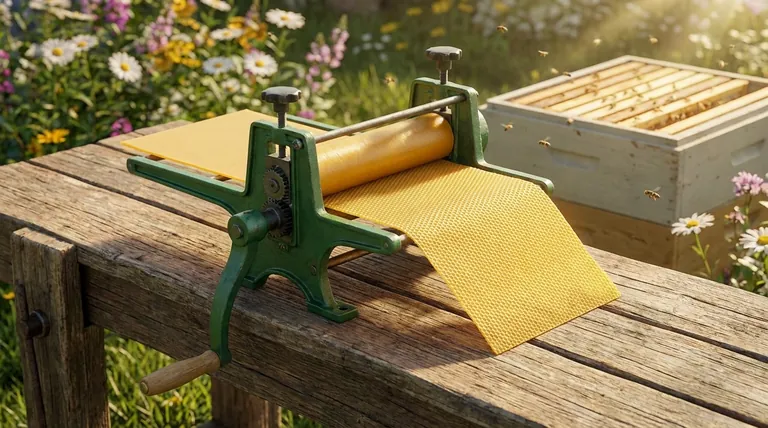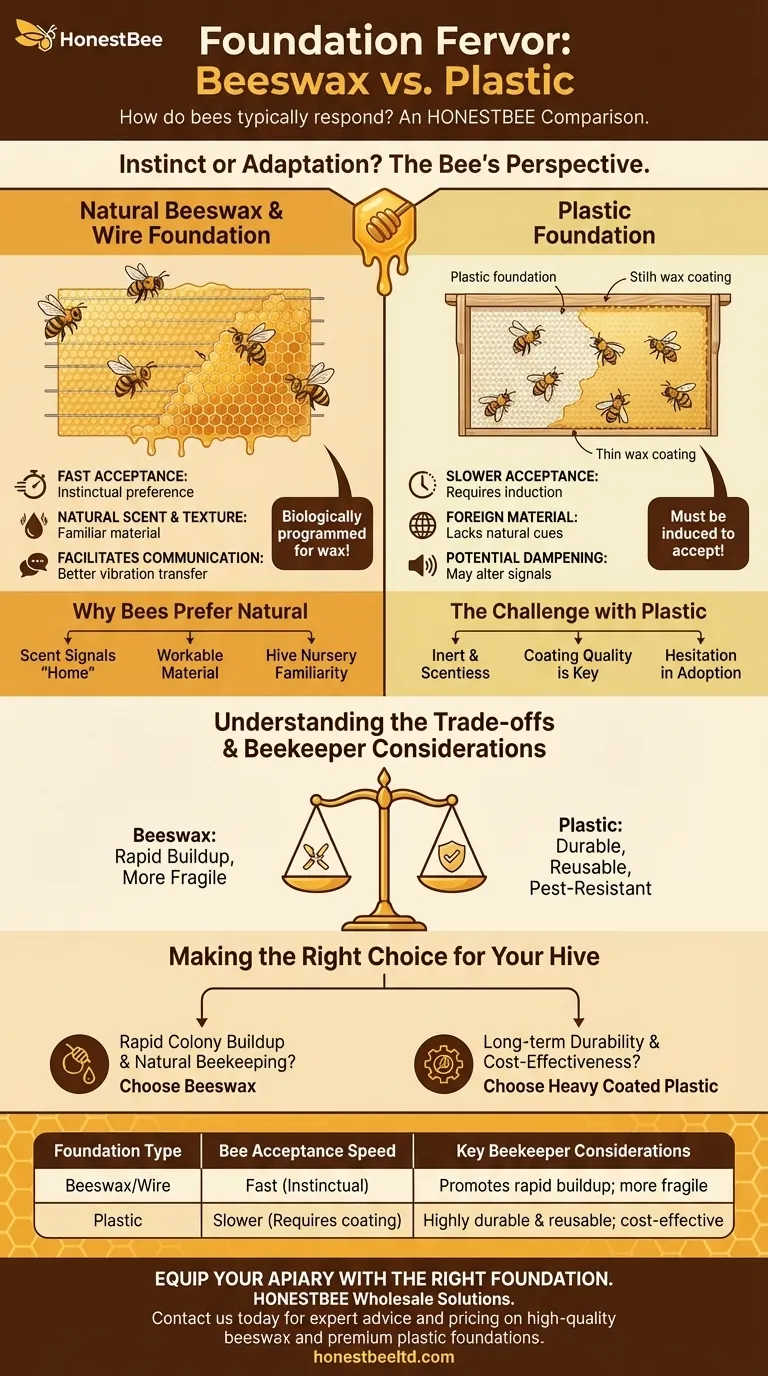In practice, bees typically accept and begin building on natural beeswax or wire-embedded wax foundations more quickly than they do on plastic foundations. This preference is rooted in the bees' natural instincts, as beeswax is the very material they produce to construct their comb. While colony behavior can vary, the natural scent and texture of real wax serve as a powerful attractant that plastic cannot replicate on its own.
The core difference lies in instinct versus adaptation. Bees are biologically programmed to work with beeswax, leading to faster acceptance, whereas they must be induced to accept plastic, which can slow down the initial comb-building process.

Why Bees Prefer Natural Wax Foundation
A bee's relationship with beeswax is deeply instinctual. Understanding this is key to interpreting their response to different foundation materials placed in the hive.
The Power of Natural Scent and Texture
Bees are highly sensitive to smells. Natural beeswax emits a faint, sweet scent that signals "home" and stimulates their wax glands, encouraging them to immediately start drawing out the comb.
The texture of beeswax is also familiar and workable for them. It is a material they are biologically designed to manipulate.
An Instinct for the Familiar
From birth, a bee is surrounded by beeswax. It's the material of their nursery, their pantry, and their communication network.
Placing a pure beeswax foundation in a hive leverages this powerful, pre-existing instinct. The bees recognize it and get to work without hesitation.
Facilitating Hive Communication
The structure of honeycomb is not just for storage; it's also a medium for communication. Bees transmit information through vibrations, and natural beeswax comb effectively carries these signals throughout the colony.
While not definitively proven, there is a belief among some beekeepers that rigid plastic may dampen or alter these subtle vibrational messages.
The Challenge with Plastic Foundation
Plastic foundation was introduced for its durability and reusability, but it presents a learning curve for a colony of bees. It is an entirely foreign material in their natural world.
A Lack of Natural Cues
Plastic is inert. It lacks the familiar scent and texture that encourages bees to start building. For this reason, virtually all plastic foundation is coated with a thin layer of beeswax.
The quality and thickness of this wax coating are the single most important factors in how quickly bees will accept a plastic frame. A poor or thin coating will often result in slow adoption or outright rejection.
Slower Acceptance Rates
Even with a wax coating, colonies often take longer to fully draw out a plastic foundation compared to a natural wax one. The bees must first accept the underlying artificial structure before committing their resources to it.
This hesitation can be more pronounced in less vigorous colonies or when nectar flow is weak.
Understanding the Trade-offs
Choosing a foundation is not simply about which one bees "like" more. It involves practical considerations for the beekeeper.
Durability vs. Natural Appeal
Plastic foundation's key advantage is its durability. It is rigid, less likely to break during honey extraction, and resistant to pests like wax moths. It can be scraped and reused for many seasons.
Beeswax foundation is fragile. It can warp in extreme heat and is easily damaged during handling and extraction, often requiring more frequent replacement.
The Role of a Heavy Wax Coating
To bridge the acceptance gap, many manufacturers offer plastic foundations with an extra-heavy wax coating. This significantly improves acceptance rates, making the plastic almost as appealing as pure wax to the bees.
However, this often comes at a higher initial cost. Some beekeepers even add their own melted beeswax to standard plastic frames to encourage adoption.
Colony and Environmental Factors
It is critical to remember that every colony has its own "personality." A strong, booming colony during a heavy nectar flow may draw out any foundation you give them, including sparsely coated plastic.
Conversely, a small or struggling colony may be much more selective and refuse to work with anything but pure beeswax.
Making the Right Choice for Your Hive
Your decision should align with your beekeeping goals, budget, and philosophy. There is no single "best" answer, only the best fit for your specific situation.
- If your primary focus is rapid colony buildup and natural beekeeping: Pure beeswax foundation is the superior choice for encouraging fast, instinct-driven comb construction.
- If your primary focus is long-term durability, cost-effectiveness, and ease of extraction: High-quality plastic foundation with a heavy wax coating offers a practical and resilient solution.
Ultimately, the most effective approach is to observe your own bees and see how they respond.
Summary Table:
| Foundation Type | Bee Acceptance Speed | Key Beekeeper Considerations |
|---|---|---|
| Beeswax/Wire | Fast - Instinctual preference | Promotes rapid buildup; more fragile |
| Plastic | Slower - Requires heavy wax coating | Highly durable and reusable; cost-effective long-term |
Equip Your Apiary with the Right Foundation
Choosing the correct foundation is critical for colony health and honey production. Whether you manage a large commercial apiary or are a distributor supplying beekeepers, HONESTBEE has the wholesale solution for you.
We supply high-quality beeswax foundations for rapid colony acceptance and premium plastic foundations with heavy wax coatings for maximum durability. Our experts can help you select the ideal equipment to match your specific beekeeping goals and conditions.
Boost your operation's efficiency and success. Let's discuss your needs and how our beekeeping supplies can benefit your business.
Contact HONESTBEE today for wholesale pricing and expert advice!
Visual Guide

Related Products
- Manual Beeswax Comb Foundation Machine Wax Foundation Mill Embossing Machine
- Colorful Silicone Beeswax Foundation Mold Mould for Beekeeping
- Beeswax Foundation Sheets Beehive Foundation for Wholesale
- Professional Frame Preparation: The HONESTBEE Electric Wire Embedder
- Food Grade Plastic bee Foundation for Bee Frames
People Also Ask
- What is the importance of soaping the rollers during milling? Prevent Wax Adhesion & Equipment Downtime
- What are the different uses of comb in a bee hive? A Guide to the Hive's Essential Architecture
- What is the function of a beeswax foundation machine? Boost Hive Efficiency and Honey Production
- What is the use of a comb foundation mill? Boost Honey Production with Strategic Hive Control
- What texture is embossed on the beeswax foundation machine? The Precise Worker Bee Cell Pattern for Hive Efficiency

















